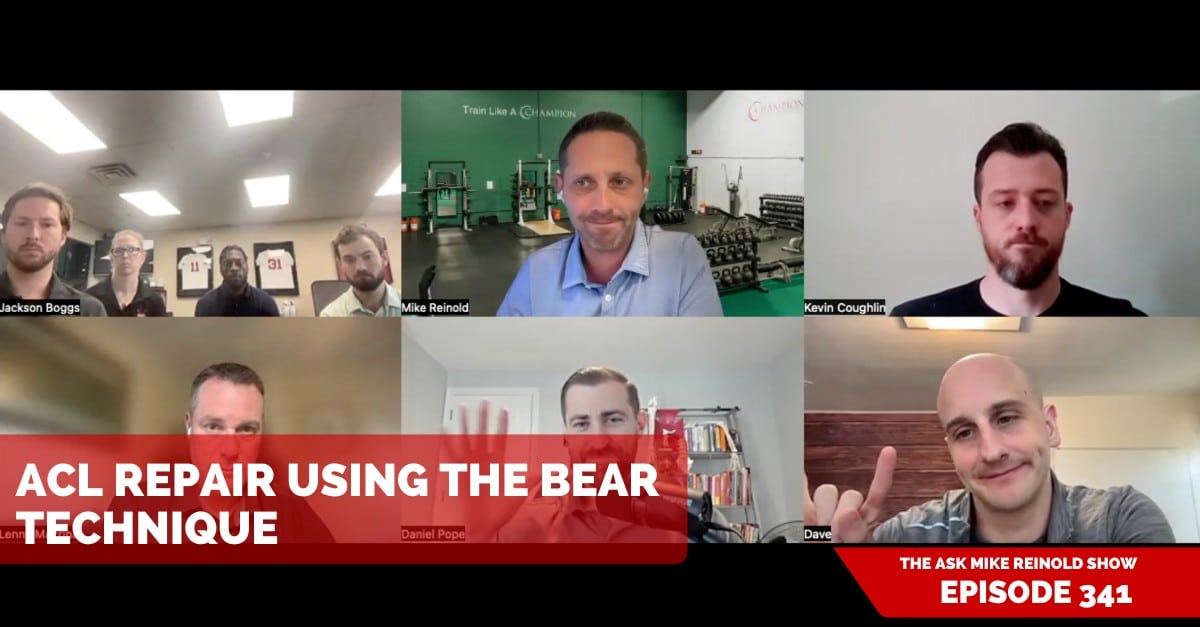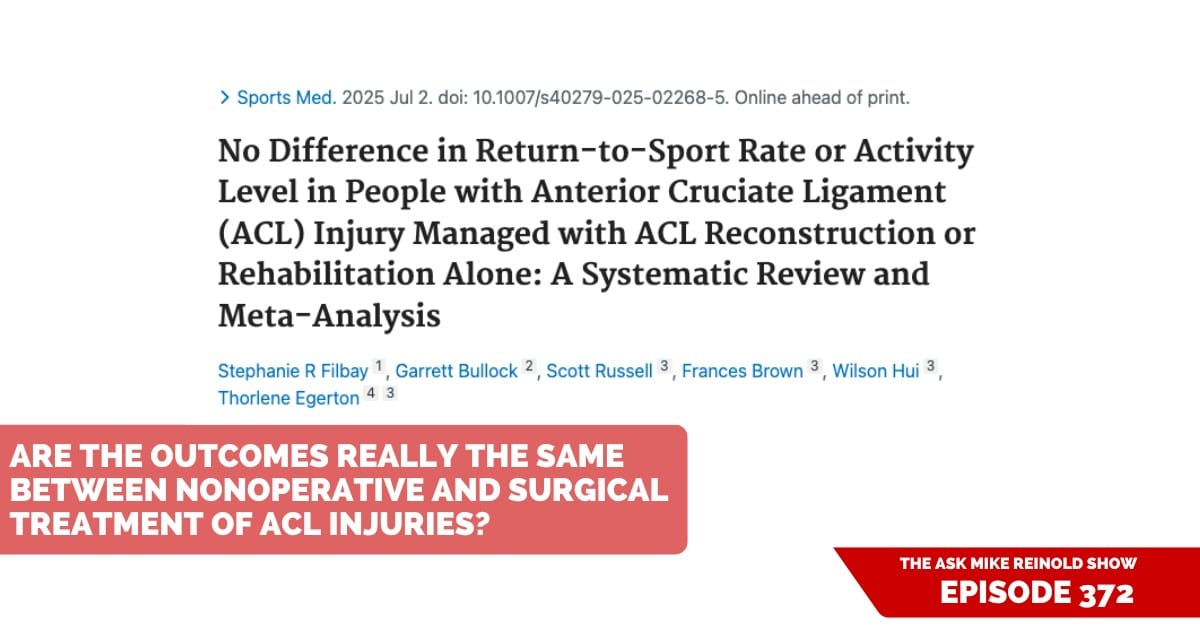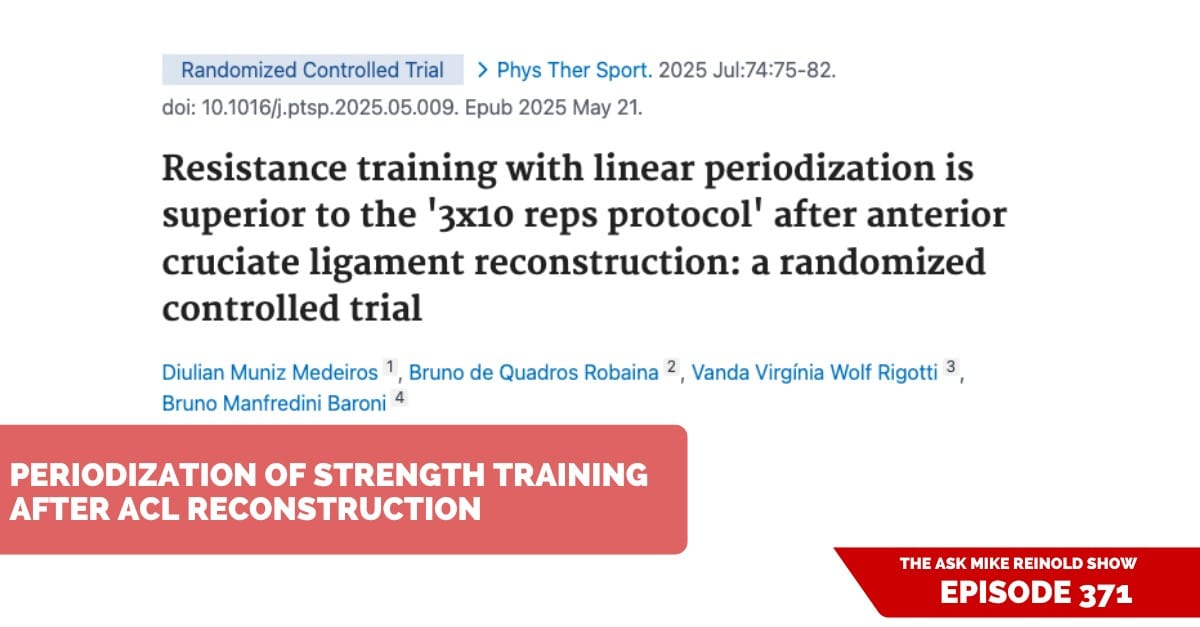The future of ACL reconstruction and repair is evolving. One of the newer techniques to try to repair the native ACL ligament rather than needing a graft is using a bridge enhancement. This is called the BEAR technique for Bridge-Enhanced ACL Repair.
This procedure has specific indications, contraindications, and rehabilitation guidelines.
In this episode, we discuss this procedure and the difference in rehabilitation between the BEAR technique and a traditional ACL reconstruction.
To view more episodes, subscribe, and ask your questions, go to mikereinold.com/askmikereinold.
#AskMikeReinold Episode 341: ACL Repair Using the BEAR Technique
Listen and Subscribe to Podcast
You can use the player below to listen to the podcast or subscribe. If you are enjoying the podcast, PLEASE click here to leave us a review in iTunes, it will really mean a lot to us. THANKS!
Show Notes
• 6 Keys to the Early Phases of ACL Rehabilitation
• The Evolution of ACL Reconstruction Rehabilitation with Airelle Giordano
Transcript
Noah Sprinkle:
I’m reading the question today. It’s about the ACL repair using the BEAR technique from the AASPT annual meeting in Las Vegas. Dr. Arun Ramappa presented on current advances in the management of the ACL tears. One of the things he mentioned was the bridge enhanced ACL repair or BEAR technique. Can you explain what this is and how the rehab differs from an ACL reconstruction?
Mike Reinold:
Awesome. Thanks, Noah. Good one. Yeah. This is one of the questions from the AASPT annual meeting. So we were in Vegas recently, and I thought we’d answer a couple of the big questions that came up at the meeting too, just because they’re really good questions. So Dr. Ramappa from Beth Israel, Chief of Sports Medicine, came over here to Vegas and joined us and had a really great presentation that was going over a lot of the different techniques. And I’ll say this, I mean the future of ACL reconstruction and repair is bright. It’s impressive some of the things that we’re getting to. So. it’s pretty neat to see some of these things.
So, BEAR technique… Len, we’re in Boston, right? So this originated from Boston Children’s Hospital, was where they started working on this the most, a little bit. You’ve rehabbed some of these now because we’ve been in Boston and have seen that from the beginning. Let’s not assume everybody knows what the BEAR technique is. So maybe we start with that and say, because it’s not a reconstruction. I think sometimes people get that confused, thinking it’s just a different type of reconstruction, but it’s a repair of your native ligament, which is amazing if we can do that. But you want to start with that, Len? What is the BEAR procedure?
Lenny Macrina:
Yeah, this is like futuristic stuff when you start thinking about it. This is stuff like, “What? We can really do this?” And apparently so. So it was Martha Murray, a surgeon at Boston Children’s Hospital, and she along with her colleagues helped develop this procedure. It’s basically… You tear your ACL. Normally, you would take a patellar tendon, your quad tendon, your hamstring, or a cadaver, take the old ACL out and you would put this graft in. Her procedure that she helped develop and got FDA approved a few years ago is utilizing your own blood. That’s it. There’s no graft, there’s no harvesting of anything besides taking some blood out of your arm I assume. And they take the two ends of the ACL. I know most people don’t watch the videos, but picture you tear your ACL, and I’m pretty sure it has to be mid-substance. It’s not going to be you rupture your ACL and it’s a full-blown explosion in your knee.
And so picture you have two ends, the femoral end and the tibia end that is still attached, but it just ruptured in the middle so they can bridge, get it bridge enhanced, bridge that gap using your own blood and this bovine medium. So this medium gets sewed between the two tears to bridge the gap and then the blood gets put into that almost like a sponge. And basically it creates this bridge, I guess to help heal the ACL. The ACL literally heals onto itself. So MRIs are showing healed ACLs, stability tests are showing healed ACLs, and second-look arthroscopies are showing healed ACLs. The caveat is the rehab as of now is pretty slow. So you picture your normal ACL patient, you’re trying to get what, 90 degrees of flexion by say two weeks, seven to 10 days, 10 to 14 days. You’re trying to get near full range of motion by say four weeks, full extension, full flexion.
With this surgery, it’s limiting range of motion to about 45 degrees of flexion for a couple of weeks. It’s getting to 90 degrees by four weeks. It’s a brace for six weeks, which is kind of typical for an ACL. And then it’s a slower progression of strengthening, usually at around 12 to 14 weeks. Things seem to normalize. You’re playing a little catch-up because it was so slow at the beginning, but around 12, 14, 15 weeks, everything’s healed. You’ve got your range of motion fully back at this point, hopefully. And you are now beginning to do more weight-bearing types up, but the protocol is somewhat slow at the beginning.
They actually did speed it up recently. I was supposed to be on a committee to help that, a PT committee to help them. It’s a company out of Massachusetts. Actually, out of Westborough, Mass called I think, I don’t want to botch their name, Mihac, Miach, M-I-A-C-H, I believe is how they spell it. And I was speaking to them recently at our meeting in Vegas, our sports academy meeting in Vegas, and it was very encouraging. They have very encouraging data. They have more data that’s going to come out soon and it seems promising. The results as of now are comparable to hamstring autografts. That’s a paper that came out maybe a year or two ago that looked at hamstring autografts and it seems like it’s a promising thing. So something to keep an eye on. This would be a procedure.
Now Kevin, you also have one right now as well. I was talking to him recently. There aren’t many doctors that are doing it. I think there’s only a few in Massachusetts. I don’t think Martha Murray, who developed it and got it FDA approved, I don’t think she is doing it because of a potential conflict. I don’t want to mess with that. So I think people in Massachusetts… There are options. And I’ve treated another doctor or a doctor who I’ve treated one personally myself, and the person did pretty well. They did well. And so I’m curious how it does in its future data, comparing it to the gold standard patellar tendon autograft. In the long term. What’s the 10, 20-year outcomes? Does this thing hold up?
Mike Reinold:
Yeah, we’ll have to wait 10, 20 years to find out on that. We’re going to have lots of test subjects in the meantime.
Lenny Macrina:
Yeah, I know.
Mike Reinold:
I mean I think some of the cool things that Lenny mentioned here, and this is probably the first one, is this isn’t for everybody. It has to be a mid-substance tear. It’s probably not somebody that’s getting back to aggressive running, cutting stuff. It’s probably not a high school athlete or a collegiate athlete that would probably rather have a bone patellar tendon bone. But heck, I joke all the time. I’ve probably said it on the podcast though, but over each decade of life you have different things. Your friends start getting married in your twenties and then you start having kids in your thirties and then you start tearing your ACL in your forties. And that’s what all my friend group did recently. So if I was in my forties and I had an option like this that was a little bit less restrictive and it was a mid-substance tear, this is pretty exciting to be able to do it. Yeah, I think that’s pretty cool.
Lenny Macrina:
I think another thing too is that the weight-bearing is limited as well. It’s a partial weight-bearing for at least a couple of weeks and that’s a little odd compared to an ACL. So you got to make sure your lifestyle can handle the limited weight-bearing component as well because you’re on crutches for a couple of weeks. But I agree with you, it seems like it’s an older, maybe the late-twenties, early-thirties kind of population. We actually did have one at Champion. She was a high school going into college soccer athlete and had it done, and she did not get back to college soccer. But I don’t think it was because of her knee. I think it was just because of other circumstance.
So we did have somebody early, early on. I think it was still, I don’t even know if it was FDA approved at that time or if she was part of an experimental group. And she, from what I can understand, had a good result. So I think it could eventually get to the sports population, but I think right now I think doctors are doing it in that athletic, older population and test running it there from what I’m gathering.
Mike Reinold:
And just like any other new procedure, right? We’re going to find our way. We’re going to find the best person. Even the rehab, this is a lot to me. This reminds me so much of Genzyme Carticel stuff with the autologous chondrocyte implantation from 20-plus years ago and you had all these strict rehab guidelines and then just like everything else, your patients don’t pay attention to your restrictions. They do great. And then we speed up the rehab protocol. It tends to be how it is, but we’ll see. I think Kevin, you wanted… Did you raise your hand a little bit? I want to see… Kevin obviously has been working with somebody recently. What are your thoughts? How’d they look? Did it look much different, feel much different for you?
Kevin Coughlin:
Yeah, I think a lot of the things Lenny just said was exactly right with the guy I’m seeing it with. So I think he’s in his late twenties and he’s a grad student and not super active, wants to get back to things like hiking and weight training and stuff like that. He also mentioned that he was the perfect candidate. He said, the doctor said where the location of the tear was a great candidate for this surgery. He did do his elsewhere, so I think he’s about week nine right now. He did do his rehab elsewhere for the first six weeks and he switched because he thought they were going way too slow and he did get some clearance from his surgeon to do a little bit more because he’s feeling so good. But yeah, I think he was partial weight-bearing for the first four weeks and then he was in his brace for the first six weeks.
So with all that, he is actually doing well and he’s feeling good. I think the difference I’ve seen with this so far compared to other ACLs that I see is where they didn’t harvest a tendon. He has a lot less pain than other people, but obviously the long-term data is really important with this. So how he’ll do long-term, I’m very interested to see. But at this point, he is doing well and he feels pretty good. He still has a fair amount of swelling, but he’s doing decent. I think the other important thing that he had mentioned to me and that I’ve read is for this, to be a candidate for this, you really have to get into surgery really quickly. I think it has to be within the first forty days or something after the tear.
Lenny Macrina:
It’s fifty days.
Kevin Coughlin:
Okay, yep. And that’s just to make sure the ligament, I guess, is still getting a decent amount…
Lenny Macrina:
Yep. Viable.
Kevin Coughlin:
Of support.
Lenny Macrina:
Yeah.
Kevin Coughlin:
Yeah. Okay.
Mike Reinold:
That makes sense.
Kevin Coughlin:
Yeah.
Mike Reinold:
Yeah, that makes sense with something like that. Yeah, Dan.
Dan Pope:
I guess the one thing that Ramappa was talking about, which I didn’t really realize, but it is exciting, is that a lot of the ACL reconstruction folks have quite a bit of osteoarthritis over the course of time and the amount of damage that goes into creating a surgery like that, it’s pretty high with a thought being like maybe that’s the reason why folks are getting more osteoarthritis. But with the BEAR procedure, it seems like that’s a little less invasive and may potentially reduce future osteoarthritis. So it does seem good. If I tore my ACL tomorrow, maybe that’d be something I’d look into just because I’d like that reduction in potential risk of osteoarthritis over time.
Mike Reinold:
Yeah, that makes sense. And that’s a big one, right Len? That’s a big thing to consider.
Lenny Macrina:
There’s a whole world that says that. I think taking, harvesting the patellar tendon, some people say patellofemoral joint gets a little beat down from that. I think another thing too is just when you tear your ACL, you get usually bone bruise in your knee and that leads to some subchondral stuff going on. So I don’t know, I’m curious if they have less arthritis long-term than, if we’re trying to blame the graft, then definitely. But I don’t know if the graft is always to blame or is to blame when you tear your ACL and what goes on in your knee. Just the synovial, just the inflammation that goes on in your knee and the increasing temperature for the cartilage and the bone bruise that goes on. I think that’s going to be more implication.
And the unloading of the knee by long-term weakness that we see develop. You don’t ever get loads through that knee, which would be another reason why the knee would break down. So we’re seeing that arthritis is more of an inflammatory thing, maybe a systemic thing, systemic inflammation as well, and not necessarily just what we traditionally think of it as. So I’d be curious again what the data shows. Yeah.
Mike Reinold:
So my understanding of the rehab and just as an outside observer here is the first four to six weeks for sure, but maybe even the first two to three months. It’s a little bit slower, but once you get to month three or so, it’s proceed just, I don’t want to say proceed the same as an ACL, but it catches up. Is that fairly accurate?
Lenny Macrina:
I would say so, yeah. I think it’s what I was trying to allude to before, is it turns into that. It’s just that early time. Can the patient be as slow and can the PT work as slow as they’re not used to? The protocol is slow, and in talking to other people, they go a little fast in the protocol. I’m not advocating for that because this is a very… I think the company is looking to get good results and they’re trying to make sure that nothing goes wrong. And so they’re making the protocol slow on purpose, I would guess. But they have sped it up, believe it or not. Whatever this protocol is saying right now in 2024, not to date the episode, but it was slower a year or two ago, and that committee did put recommendations to help speed it up a little. And I think we’re on version… If you Google search it, I think it’s like version H is the version that it’s on. It’s going by the alphabet. And so there were numerous versions ahead that were slower than this. So, yeah.
Mike Reinold:
But they can’t have more than 26 versions though. That’s going to be a problem, right?
Lenny Macrina:
Yeah, you could go like a spreadsheet, go, AA.
Mike Reinold:
Right. That’s a good point. Well, anyway, it’s exciting. I’d like to think when we do a new procedure like this, let’s say like Tommy John, you go from a big reconstruction to that internal brace, which isn’t quite the same as this, but it’s a repair with an internal brace. It’s not too far-fetched, which by the way, they are doing that with ACLs. But what happened with Tommy Johns is we could go faster because of it. You have the right kind of thing, you can go faster. I mean, this doesn’t really change any of that. So again, if you can endure the pain, patellar tendon versus this, it’s just another thing to talk about. But again, I think it goes down to the person.
So lots to learn, a lot more coming on the horizon with this BEAR technique that we’re pretty excited about. I love stuff like this. It’s amazing to think of where we were 20, 30 years ago and where we are now with what we can do. So again, I would say the future’s bright. So, great question. If you have something like that, head to mikereinold.com. Click on that podcast link and ask away. And please head to Spotify, Apple Podcast, rate, review, subscribe to this, see that you get notifications of the next episode and we’ll see you then. Thanks so much. Take care.





